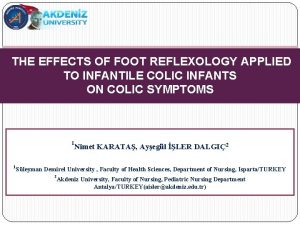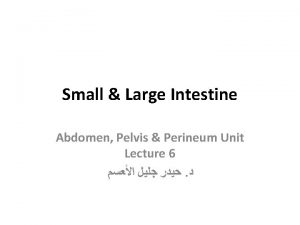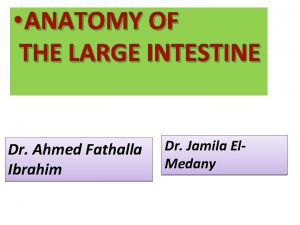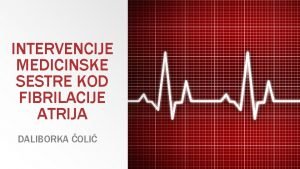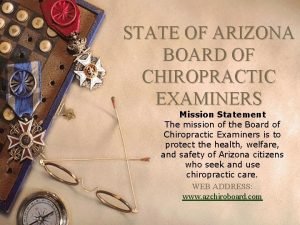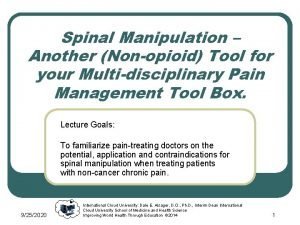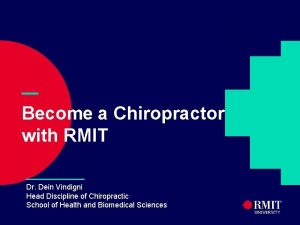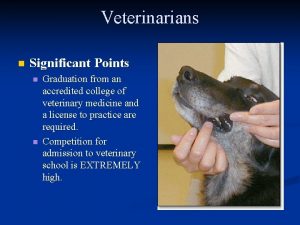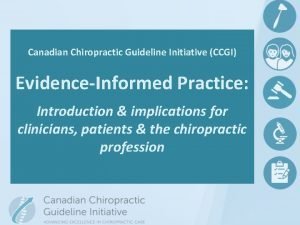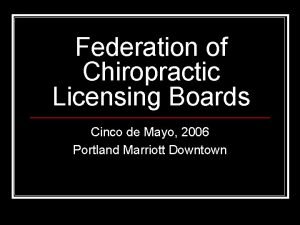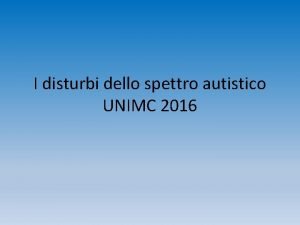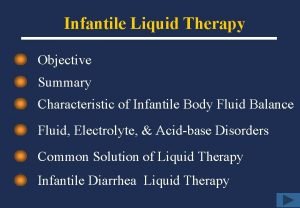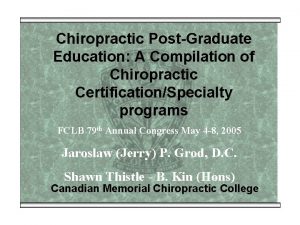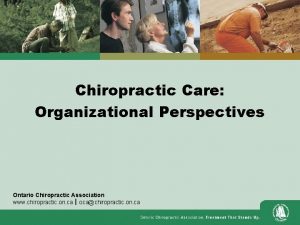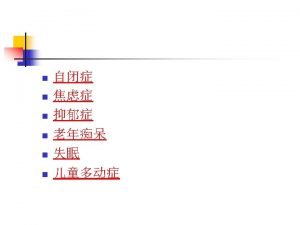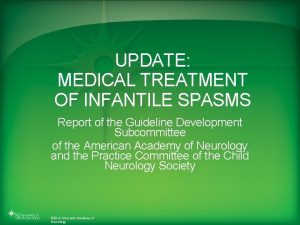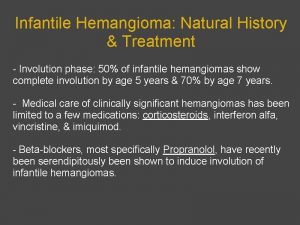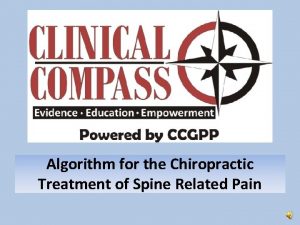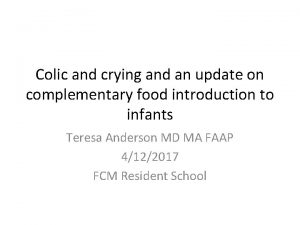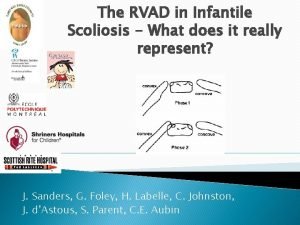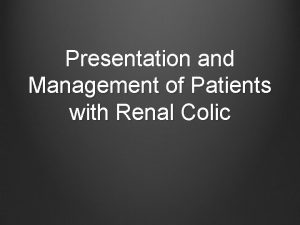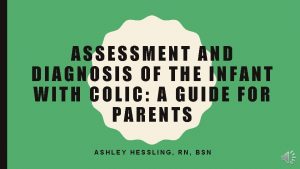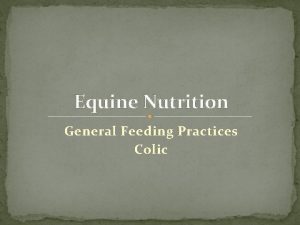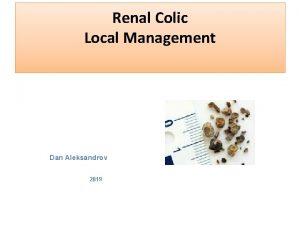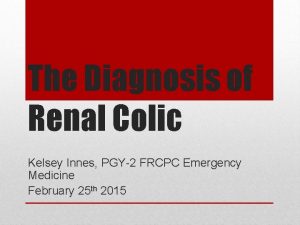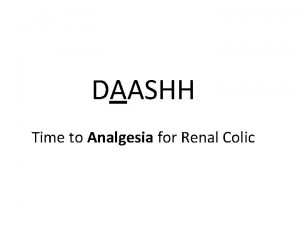INFANTILE COLIC AND CHIROPRACTIC TREATMENT WHAT DOES THE




























- Slides: 28

INFANTILE COLIC AND CHIROPRACTIC TREATMENT. WHAT DOES THE EVIDENCE SAY? Dr Bruce Walker DC, MPH, Dr. PH. Senior Lecturer in Evidence Based Practice and Public Health. School of Chiropractic and Sports Science, Murdoch University 1

Definition of infantile colic 2 Unexplainable and uncontrollable crying in babies from 0 to 3 months old; For more than 3 hours a day, more than 3 days a week for 3 weeks or more, Usually in the afternoon and evening hours. Higher pitch crying Infants are otherwise healthy, thriving, and have a normal weight gain

Physical signs (with crying) 3 Motor unrest; often flexing knees against the abdomen; or extending the trunk, neck, and extremities During attacks the infant cannot (or only temporarily) be comforted by (a) being picked up, walked, or cradled; (b) change of nappy; (c) being offered a dummy

“Known alternate causes” 4 Reflux Lactose or soy intolerance Individual temperament Early teething

Magnitude of the problem 5 The incidence (new cases) of infantile colic among newborns is estimated to be between 8% and 49% in different studies. An average of these estimates would put the incidence of infantile colic at 22. 5%

“Colic” natural history 6

Implications of “colic” 7 Infantile colic can lead to a negative motherchild relationship, which may persist for up to 3 years. Troublesome and screaming infants are in a high-risk group for ill treatment, for possible central nervous system damage, and even death from being shaken (shaken infant syndrome).

The cause of infantile colic remains unknown. 8 Investigations have not shown a direct link with: Air in the gut Constrictions in the intestines Gastrointestinal transit time Level of intestinal hormones Faecal analysis Intestinal microflora Markers of intestinal damage Occult blood Hydrogen-ion concentration in the breath Various modes of birth delivery Epidural analgesia General anaesthesia Intravenous oxytocin

Numerous treatments 9 No effect Equivocal effect Positive effect Music Sound or vibrations simulating a car Phenobarbital Meperidine Homatropine Merbentyl Dimethicone Sucrose Gripe water Alcohol Atropine Cow’s milk free diet Breastfeeding? Low allergen maternal diet Counselling and support to the parents

Chiropractic and colic 10 Chiropractic treatment is frequently used in infantile colic and both parents and chiropractors have reported a favourable effect Biologically plausible?

What does the evidence say? 11 There have been two randomised clinical trials Both in Scandanavia Wiberg JMM, Nordsteen J, Nilsson N. The short-term effect of spinal manipulation in the treatment of infantile colic: a randomized controlled clinical trial with a blinded observer. J Manipulative Physiol Ther 1999; 22: 517– 22 Olafsdottir E, Forshei S, Fluge G, Markestad T Randomized controlled trial of infantile colic treated with spinal manipulation. Arch Dis Child 2001 , 84: 138 -141 Have you read them?

WIBERG ABSTRACT 12 Objective: To determine whethere is a short-term effect of spinal manipulation in the treatment of infantile colic. Design: A randomized controlled trial. Setting: A private chiropractice and the National Health Service’s health visitor nurses in the Copenhagen, Denmark. Subjects: Infants seen by the health visitor nurses, who fulfilled the diagnostic criteria for infantile colic. Intervention: One group received spinal manipulation for 2 weeks, the other was treated with the drug dimethicone for 2 weeks. Outcome Measure: Changes in daily hours of crying as registered in a colic diary. Results: By trial days 4 to 7, hours of crying were reduced by 1 hour in the dimethicone group compared with 2. 4 hours in the manipulation group (P =. 04). On days 8 through 11, crying was reduced by 1 hour for the dimethicone group, whereas crying in the manipulation group was reduced by 2. 7 hours (P =. 004). From trial day 5 onward the manipulation group did significantly better that the dimethicone group. Conclusion: Spinal manipulation is effective in relieving infantile colic.

Critical appraisal Are the results of the study valid? Was the assignment of patients to treatments randomised properly with concealment? Sample size? Were the groups similar at baseline? Were all patients who entered the trial properly accounted for and attributed at its conclusion? Was follow-up long enough? Were all patients randomised analysed in the groups to which they were randomised? ITT? < ITT to be explained> Were patients, health workers, and study personnel “blind” to treatment? Were the groups similar at the start of the trial? 13

Are the results valid? 14 Aside from the experimental intervention, were the groups treated equally? What are the results? How large was the treatment effect? How precise was the estimate of the treatment effect? CI’s ? Will the results help me in caring for my patient? Were all clinically important outcomes considered? Are the likely treatment benefits worth the potential harms and costs?

How should drop outs be handled? Intention to treat analysis. Base Wk 1 Wk 2 Wk 3 Wk 4 4. 0 2. 5 3. 0 1. 1 2. 6 2. 5 2. 2 2. 5 6. 6 3. 5 4. 4 5. 2 8. 0 7. 2 9. 6 6. 0 4. 3 2. 7 3. 6 6. 0 5. 0 2. 5 0. 6 Wk 5 Wk 10 1. 1 1. 2 2. 2 7. 2 2. 7 2. 2 0. 6 3. 7 15

Guidelines. Wiberg paper. 16 Was the assignment of patients to treatments randomised? Sample size? Yes, but unclear how this was done. “Drawing of a ticket”. Allocation concealment unclear. No sample size calculation. Were all patients who entered the trial properly accounted for and attributed at its conclusion? Drop outs were counted. Was follow-up complete? Not followed up completely for at least 4 of the 9 drop outs. It is unclear what the status of these babies were.

Guidelines 17 Were all patients analysed in the groups to which they were randomised? No, there was no Intention-to-Treat analysis, but if there were? Were patients, health workers, and study personnel “blind” to treatment? Yes for the assessor only. Parents and chiros: No Were the groups similar at the start of the trial? Yes, except for age at colic debut.

Guidelines 18 Aside from the experimental intervention, were the groups treated equally? Yes and no. They were for many variables of interest, but it is unclear who prescribed and administered the Dimethicone and whethere was compliance. What are the results? Change in colic (hrs per day) were decreased in SMT group How large was the treatment effect? About 1. 5 hours a day reduction. Is this important? How precise was the estimate of the treatment effect? Authors used SE rather than CI’s

Guidelines 19 Will the results help me in caring for my patient? Possibly, but this was the first RCT. Were all clinically important outcomes considered? What do you think? There was hours of crying, plus: The diary registered the following for each 24 hours. 1. The infants periods of being awake, sleeping, and crying 2. Bowel movements 3. Feeding patterns Are the likely treatment benefits worth the potential

Olaffsdotir Abstract 20 Aims—To investigate the efficacy of chiropractic spinal manipulation in the management of infantile colic. Methods—One hundred infants with typical colicky pain were recruited to a randomised, blinded, placebo controlled clinical trial. Results—Nine infants were excluded because inclusion criteria were not met, and five dropped out, leaving 86 who completed the study. There was no significant effect of chiropractic spinal manipulation. Thirty two of 46 infants in the treatment group (69. 9%), and 24 of 40 in the control group (60. 0%), showed some degree of improvement. Conclusion—Chiropractic spinal manipulation is no more effective than placebo in the treatment of infantile colic. This study emphasises the need for placebo controlled and blinded studies when investigating alternative methods to treat unpredictable conditions such as infantile colic.

Guidelines. Olafsdottir paper Was the assignment of patients to treatments randomised YES and concealed but generation of assignment unclear Were all patients who entered the trial properly accounted for and attributed at its conclusion? What about sample size? A) YES they accounted for all babies including exclusions and drop outs and b) NO, there was no sample size calculation. Was follow-up complete? YES and NO: There were 5 drop-outs (4 controls). No information about these? 21

Guidelines 22 Were patients analysed in the groups to which they were randomised? YES, there was Intention-to-Treat analysis No details of which type of ITT given Were patients, health workers, and study personnel “blind” to treatment? YES, except for the chiropractor Were the groups similar at the start of the trial? YES, except for gender, but this wasn’t considered important

Guidelines Aside from the experimental intervention, were the groups treated equally? YES, they received the same counselling, support, exam; but what about other treatments at home? What are the results? There was improvement but no difference between groups. How large was the treatment effect? See table over page >>>>> How precise was the estimate of the treatment effect? CIs were mentioned but not provided. 23

Improvement comparison 24 Thirty two of 46 infants in the treatment group (69. 9%), and 24 of 40 in the control group (60. 0%), showed some degree of improvement.

Group comparison 25

Guidelines 26 Will the results help me in caring for my patient? YES, this is evidence chiropractic spinal manipulation is no more effective than placebo in the treatment of infantile colic. Were all clinically important outcomes considered? What do you think? Hours of crying and parental opinion. Are the likely treatment benefits worth the potential harms and costs? Based on the evidence: No

Conclusion 27 Based on the evidence it is doubtful chiropractic treatment has a greater effect than placebo for infantile colic

Questions? 28 More reading: http: //chiromt. com/content/18/1/17
 Infantile colic criteria
Infantile colic criteria Gallstone anatomy
Gallstone anatomy Porta hepatis contents
Porta hepatis contents Appendix structure
Appendix structure Appendix omentalis
Appendix omentalis Umihana colic
Umihana colic Is cecum intraperitoneal or retroperitoneal
Is cecum intraperitoneal or retroperitoneal Daliborka colic
Daliborka colic Peptic ulcer definition
Peptic ulcer definition Colic impression spleen
Colic impression spleen Sand colic
Sand colic Matea colic
Matea colic Spinoumbilical line
Spinoumbilical line Tihana colić
Tihana colić Az board of chiropractic
Az board of chiropractic Omm vs chiropractic
Omm vs chiropractic Dein vindigni
Dein vindigni Chiropractic marketing flyers
Chiropractic marketing flyers Nnn chiropractic
Nnn chiropractic Fclb pace
Fclb pace Canadian chiropractic guideline initiative
Canadian chiropractic guideline initiative Cinco de mayo chiropractic
Cinco de mayo chiropractic Infantile nystagmus
Infantile nystagmus Short lookers
Short lookers Definition de maladie infantile
Definition de maladie infantile Infantile swallowing pattern
Infantile swallowing pattern Botulisme infantile
Botulisme infantile Infantile swallowing pattern
Infantile swallowing pattern Neuropsichiatria infantile unimc
Neuropsichiatria infantile unimc
